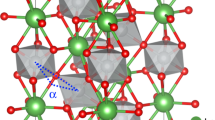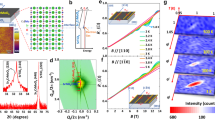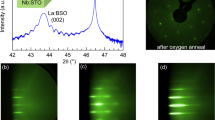Abstract
Perovskite oxides exhibit a plethora of exceptional properties, providing the basis for novel concepts of oxide-electronic devices. The interest in these materials is even extended by the remarkable characteristics of their interfaces. Studies on single epitaxial connections between the wide-bandgap insulators LaAlO3 and SrTiO3 have revealed them to be either high-mobility electron conductors or insulating, depending on the atomic stacking sequences. For device applications, as well as for a basic understanding of the interface conduction mechanism, it is important to investigate the electronic coupling of closely spaced complementary interfaces. Here we report the successful realization of such coupled interfaces in SrTiO3–LaAlO3 thin-film multilayer structures. We found a critical separation distance of six perovskite unit cell layers, corresponding to approximately 23 Å, below which a decrease of the interface conductivity and carrier density occurs. Interestingly, the high carrier mobilities characterizing the separate conducting interfaces are found to be maintained in coupled structures down to subnanometre interface spacing.
This is a preview of subscription content, access via your institution
Access options
Subscribe to this journal
Receive 12 print issues and online access
$259.00 per year
only $21.58 per issue
Buy this article
- Purchase on Springer Link
- Instant access to full article PDF
Prices may be subject to local taxes which are calculated during checkout




Similar content being viewed by others
References
Ahn, C. H., Triscone, J. M. & Mannhart, J. Electric field effect in correlated oxide systems. Nature 424, 1015–1018 (2003).
Dagotto, E. Complexity in strongly correlated electron systems. Science 309, 257–262 (2005).
Ohtomo, A. & Hwang, H. Y. A high-mobility electron gas at the LaAlO3/SrTiO3 heterointerface. Nature 427, 423–426 (2004).
Ando, T., Fowler, A. B. & Stern, F. Electronic properties of two-dimensional systems. Rev. Mod. Phys. 54, 437–672 (1982).
Eisenstein, J. P. & MacDonald, A. H. Bose–Einstein condensation of excitons in bilayer electron systems. Nature 432, 691–694 (2004).
Rijnders, G. J. H. M., Koster, G., Blank, D. H. A. & Rogalla, H. In situ monitoring during pulsed laser deposition of complex oxides using reflection high-energy electron diffraction under high oxygen pressure. Appl. Phys. Lett. 70, 1888–1890 (1997).
Koster, G., Kropman, B. L., Rijnders, G. J. H. M., Blank, D. H. A. & Rogalla, H. Quasi-ideal strontium titanate crystal surfaces through formation of strontium hydroxide. Appl. Phys. Lett. 73, 2920–2922 (1998).
Koster, G., Rijnders, G. J. H. M., Blank, D. H. A. & Rogalla, H. Imposed layer-by-layer growth by pulsed laser interval deposition. Appl. Phys. Lett. 74, 3729–3731 (1999).
Den Dekker, A. J., Van Aert, S., Van den Bos, A. & Van Dyck, D. Maximum likelihood estimation of structure parameters from high resolution electron microscopy images. Part I: A theoretical framework. Ultramicroscopy 104, 83–106 (2005).
Nakagawa, N., Hwang, H. Y. & Muller, D. A. Why some interfaces cannot be sharp. Nature Mater. 5, 204–209 (2006).
Kalabukhov, A. S. et al. The role of oxygen vacancies in SrTiO3 at the LaAlO3/SrTiO3 interface. Preprint at <http://arxiv.org/abs/cond-mat/0603501> (2006).
Siemons, W. et al. Origin of the unusual transport properties observed at hetero-interfaces of LaAlO3 on SrTiO3. Preprint at <http://arxiv.org/abs/cond-mat/0603598> (2006).
Ohtomo, A., Muller, D. A., Grazul, J. L. & Hwang, H. Y. Artificial charge-modulation in atomic-scale perovskite titanate superlattices. Nature 419, 378–380 (2002).
Okamoto, S. & Millis, A. J. Electronic reconstruction at an interface between a Mott insulator and a band insulator. Nature 428, 630–633 (2004).
Okamoto, S. & Millis, A. J. Theory of Mott insulator-band insulator heterostructures. Phys. Rev. B 70, 075101 (2004).
Okuda, T., Nakanishi, K., Miyasaka, S. & Tokura, Y. Large thermoelectric response of metallic perovskites: Sr1−xLaxTiO3 (0≤x≤0.1) . Phys. Rev. B 63, 113104 (2001).
Henrich, V. E., Dresselhaus, G. & Zeiger, H. J. Surface defects and the electronic structure of SrTiO3 surfaces. Phys. Rev. B 17, 4908–4921 (1987).
Nishimura, J., Ohtomo, A., Ohkubo, A., Murakami, Y. & Kawasaki, M. Controlled carrier generation at a polarity-discontinued perovskite heterointerface. Jpn J. Appl. Phys. 43, L1032–L1034 (2004).
Acknowledgements
This work is part of the research programme of the Foundation for Fundamental Research on Matter (FOM, financially supported by the Netherlands Organisation for Scientific Research (NWO)) and Philips Research. A.B., D.H.A.B., H.H. and G.R. acknowledge additional support from NWO. S.B. and S.V.A. are grateful to the Fund for Scientific Research-Flanders. The authors also acknowledge B. Freitag, A. J. Millis, Y. Ponomarev, F. J. G. Roesthuis, H. Rogalla, R. Wolters, W. van der Wiel, D. Veldhuis and the FEI Company.
Author information
Authors and Affiliations
Corresponding author
Ethics declarations
Competing interests
The authors declare no competing financial interests.
Rights and permissions
About this article
Cite this article
Huijben, M., Rijnders, G., Blank, D. et al. Electronically coupled complementary interfaces between perovskite band insulators. Nature Mater 5, 556–560 (2006). https://doi.org/10.1038/nmat1675
Received:
Accepted:
Published:
Issue Date:
DOI: https://doi.org/10.1038/nmat1675
This article is cited by
-
Transition from a uni- to a bimodal interfacial charge distribution in \(\hbox {LaAlO}_3\)/\(\hbox {SrTiO}_3\) upon cooling
Scientific Reports (2020)
-
Electronic Reconstructions in the Transition Metal–Free Heterostructures: LaAlO3/SrGeO3
Journal of Superconductivity and Novel Magnetism (2020)
-
Electrical polarization induced by atomically engineered compositional gradient in complex oxide solid solution
NPG Asia Materials (2019)
-
2D hole gas seen
Nature Materials (2018)
-
Direct observation of a two-dimensional hole gas at oxide interfaces
Nature Materials (2018)



